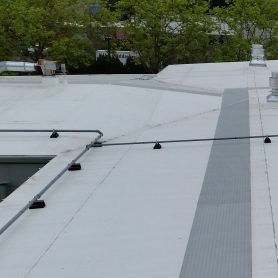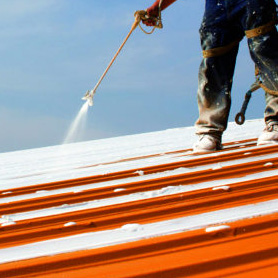Homeowners and constructors always look for new ways to secure the roof systems of homes and construction sites.
To provide a strong coating for a roof, many of these constructors use silicone coatings and try to paint over them after a few years. But can you paint over silicone roof coating?
If you are a constructor or a painter, you may have found yourself in a situation where you must apply a coat of paint over a silicone roof.
To ensure the paint sticks to your silicone roof coating, you may need to consider the pros and cons of painting over silicone roof coatings.
The question is, can you paint over silicone roof coating? Read on to find out.
Can you Paint over the Silicone Roof Coating?
The answer to whether silicone roof coatings can be painted over is that you can paint over silicone roof coatings.
Although many people think that you cannot paint over a silicone coating, the reality is that it is possible to paint over a silicone coating if the proper technique is applied.
A little bit of training and good paint is all that is required to paint over silicone.
For painting over a silicone roof coating, you may need high-emulsion paint that sticks to the surface and does not wear off easily.
The Problems of Silicone Roof Coatings
Some of the problems that silicone roof coatings present and are a hurdle to painting over them are:
Silicone coating is slippery
Walking on can be very slippery when a silicone roof coating gets wet. In areas with high foot traffic, such as near air conditioners, contractors must apply a layer of sand to the wet coating to provide more stability.

This sand can provide some strength to handle surface abuse when these air conditioner units are being repaired or installed.
Important to examine the roof’s condition before applying paint
Before a silicone roof coating is done, the roof’s condition is first examined. Ensure the roof’s condition is not deplorable before applying the paint coat.

These roofs should possess intact seams of the existing membrane. In addition, the roof needs to be maintained properly and cleaned frequently to get a good silicone coating.
Silicone roof coating’s shine wears out.
When a silicone coating is first installed on a roof, it is shiny and elegant, but after a few years, it loses its shine.
The reasons for the loss of this shine are leaves, dirt, and algae that might stick to the silicone roof coating.
Silicone coating may be hard on built-up roofs.
The built-up roofs often have an uneven surface with gravel and stones on the outer layer.
Silicone coating may not work on these surfaces as they are rocky and uneven, making it hard to use silicone coating over the rough surface.
It requires recoating with silicone.
If you have a silicone roof coating, you may need to recoat it with more silicone in the future, owing to wear related to weather and dust.

In addition, removing the silicone coating to apply another layer can be difficult, as it is not removed easily.
It can be not easy to repair.
Silicone coatings are difficult to repair as new paint cannot adhere to the surface unless the old one is peeled off.
However, if the new coat is applied with the right technique, it can adhere to the silicone coating surface and last longer.
The Benefits of Silicone Roof Coatings
Although silicone roof coatings can be difficult to paint over, the benefits offered by this silicone coating are numerous:
Silicone coatings are the fastest to apply
Silicone roof coatings are the fastest and easiest to apply as they can be spread or rolled on the surface.
With faster and easier coating, there are multiple benefits, such as faster coating, which can be done in a shorter time, and the absence of waste disposal as a new coat can be applied over the old one, reducing waste disposal costs.
The silicone coating can easily be applied over butanol, long-run iron, and decramastic coatings.
Silicone roof coatings last longer.
The silicone coatings are easy to paint, and when they need repair after 3-4 years, they need to be cleaned and recoated to deliver protection for another 10-15 years.
Silicone roof coatings’ longevity means they can be maintained longer than conventional ones.
Silicone roof coatings are durable.
Silicone roof coatings can withstand building movements such as earthquakes, temperature fluctuations, and oxidation.
![]()
They also have a high UV resistance and can provide durability even in extreme temperatures.
Moreover, the silicone coating is water-resistant and can withstand water ponding for a long time.
How to Paint over Silicone Roof Coating?
Some options can help roof contractors paint over silicone: Remember to use oil-based paints as they use solvents; silicone coating is unlikely to repel the paint if a solvent is used.
The steps to paint over silicone roof coatings are as follows:
Step 1: Examine the coating
Examine the silicone roof coating for cracks, blisters, open seams, or tears. Attention skylights, pipes, vents, and any joining parapet walks and attachments.
Ensure the roof coating is in good condition before applying paint over the surface.
It is advised to let the coat of paint dry out completely before another coat is applied.
Step 2: Apply Paint over the Silicone Coating
For applying paint over the silicone coating, you may need a brush or a roller and solvent emulsion paint, which is much more likely to stick to the silicone coating. To apply the coatings, follow these steps:
- Thoroughly clean the silicone coating on the roof. Try to work on one section at a time and sweep off any puddles that form on the way. Use an inexpensive solution such as TSP or a substitute filled in a bucket of water.
- Do not allow any wash water to dry on the walls, roof crevices, and windows.
Step 3: Avoid over-rolling the paint.
Paint from the bail and cover areas of the roof that need attention, such as marks created by ponding. Apply two coats of topcoat at a minimum of 20 mils dry coat.
You can also use a roller to spread the paint or spread the paint over the roof.
Ensure proper inspection of the paint coating after you are done so that no area is left out. You can also save any leftover paint for repairs in the future.
Conclusion
Silicone roof coatings are one of the most durable roof coatings on the market. But they can lose their shine after a few years and must be repaired.
But can you paint over silicone roof coatings? The answer is yes; with the proper technique, you can apply a coat of paint over the silicone roof, increasing its longevity and durability.

Arthur is a skilled roof worker with over 10 years of experience in the industry. He started his career as an apprentice and worked his way up to become a foreman.
When he’s not working on roofs, John enjoys with his family or writing posts. He is also a passionate cyclist.
